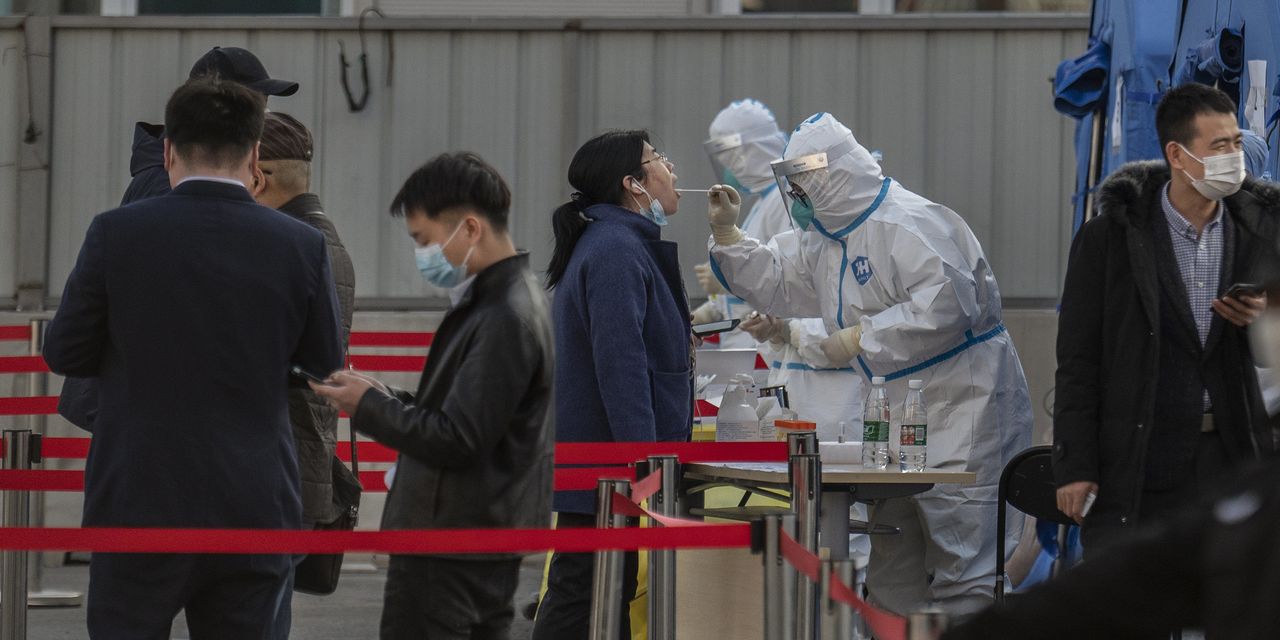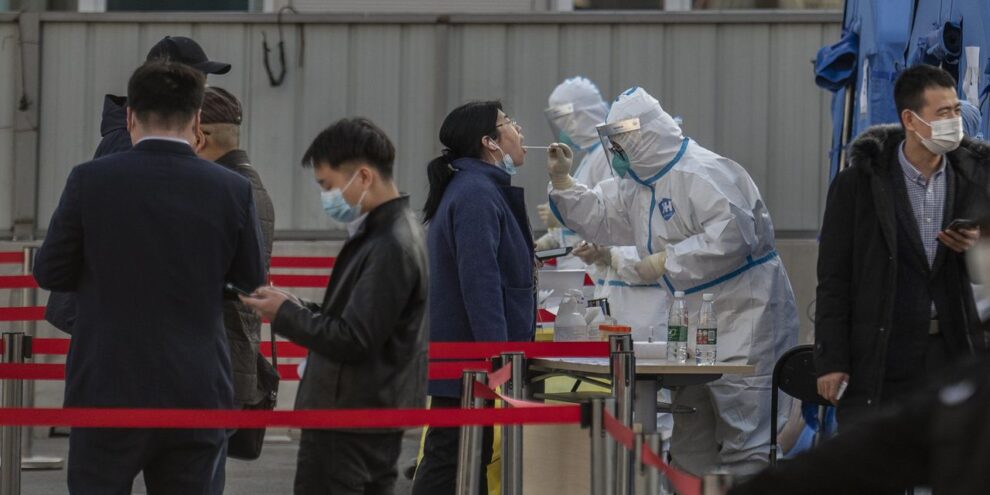
U.S. stocks rose Tuesday afternoon, finding support after a smaller-than-expected rise in a measure of wholesale inflation and a pullback in previously soaring oil prices.
Investors continued to monitor developments in the Russia-Ukraine war and prepared for the kickoff of a two-day Federal Reserve policy meeting that’s fully expected to conclude with a benchmark interest rate increase. The meeting will be closely watched for clues to further monetary tightening.
What are major indexes doing?
- The Dow Jones Industrial Average DJIA, +1.22% rose almost 372 points, or 1.1%, to about 33,313.
- The S&P 500 SPX, +1.39% was up almost 54 points, or 1.3%, at 4,227.
- The Nasdaq Composite COMP, +1.85% advanced 228 points, or 1.8%, to 12,809.
On Monday, the Dow Jones Industrial Average eked out a gain of around one point, while the S&P 500 declined 0.7% and the Nasdaq Composite dropped 2%.
What’s driving markets?
Stock indexes were buoyed after a softer-than-expected reading on U.S. wholesale prices was released Tuesday.
The U.S. February producer-price index showed a monthly rise of 0.8%, lower than 0.9% rise that economists surveyed by The Wall Street Journal had forecast. The year-over-year rate was unchanged at 10%, the highest level in decades.
The monthly rise was “boosted by blistering strength in commodities as energy jolted” 8.2% month-over month while “food burst” 1.9% higher on the same basis, according to an economics report from BofA Global Research on Tuesday.
The PPI data also showed that core wholesale prices, which excludes food, energy and retail trade margins, rose just 0.2% and also came in below expectations.
“We would be careful reading into the softer core readings as these data can be choppy from month to month,” wrote Alexander Lin, a U.S. economist with BofA, in the Wall Street firm’s research report. “Underlying inflation pressures likely remain elevated given constrained supply chains and tightening labor markets.”
Equities valuations have been “cheapening” and are starting to become attractive, “but it is a little tough to pull the trigger here,” said Frank Rybinski, chief macro strategist at Aegon Asset Management, in a phone interview Tuesday. Aegon is “neutral” equities overall, a shift from last year when the firm was “overweight.”
“We are starting a Fed cycle,” said Rybinski. Also, “we’d like to get a little clarity” on the Russia-Ukraine war.
While the economic readings may have cheered traders worried about inflation, they’re seen as unlikely to alter the Fed’s path. Policy makers kick off a two-day meeting Tuesday, and are fully expected to make a quarter-point rate increase on Wednesday.
The Dutch bank ABN Amro is expecting seven quarter-point rate hikes this year, and another three next year. “Despite the growth dampening effects of higher commodity prices, the conflict makes the case even stronger for rate hikes, rather than weaker,” said Bill Diviney, senior economist at ABN Amro.
In other U.S. economic data released Tuesday, the New York Fed’s Empire State manufacturing index slumped 14.9 points to negative 11.8 in March. Economists had expected a reading of 5.5.
Rybinski pointed to “a silver lining” in the Empire State survey, though, saying it found that “businesses see optimism when they look out” six months, which should bode well for jobs, payrolls and capital expenditures. Within equities, Rybinski said he’s “overweight” the U.S.
A retreat by oil prices was seen lending support to stocks. The U.S. benchmark CL.1, -6.49% was down around 6% Tuesday afternoon, trading at $96.58 a barrel. Crude surged to a 14-year high around $130 a barrel last week on fears over supply disruptions as a result of Russia’s invasion of Ukraine.
Meanwhile, China’s at the heart of two stories that worry investors. U.S. and Chinese officials met in Rome on Monday, with little apparent agreement, as American negotiators said Russia was looking to circumvent sanctions by procuring Chinese arms. U.S. officials have threatened to also sanction China.
At the same time, China’s been fighting a coronavirus outbreak, tightening controls at ports after locking down the technology and finance hub of Shenzhen. Beijing also locked down Changchun, an auto center in the northeast, the Associated Press reported, with bus service to Shanghai, China’s business capital and biggest city, suspended
“In terms of catalysts, it is a bit of a perfect storm, with a sharp rise in COVID cases in China and implications for demand and supply chains and further worries about the China-Russia relationship and possible sanctions if China was to provide support to Russia visibly,” said Stephen Innes, managing partner at SPI Asset Management.
The Hang Seng HSI, -5.72% slumped 5.7% in Hong Kong, and the Shanghai Composite SHCOMP, -4.95% dropped about 5%.
See also: War in Ukraine: Capital city barraged; three EU nation leaders to visit
The COVID lockdowns were seen contributing to the retreat in oil prices, though market watchers said volatility in commodity prices around the war would remain a source of concern. The Organization of the Petroleum Exporting Countries on Tuesday warned in a monthly report that the Russia-Ukraine war could stoke inflation and end up undercutting demand for as the cartel placed its forecasts for oil demand growth, supply growth and the global economy “under assessment” due to heightened uncertainty.
Read: OPEC says Russia-Ukraine war could undercut oil demand, puts forecasts ‘under assessment’
“Fortunately, oil is off its high, but anything could happen and its path ahead will be important to the Fed,” said John Vail, chief global strategist at Nikko Asset Management, in a note. “The Fed is also cognizant of the 1960s when political considerations, the Vietnam War in that case, were used to pressure the Fed to remain dovish but unfortunately eventually led to sustained high inflation.”
Which companies are in focus?
- Airline stocks were in the spotlight. JetBlue Airways Corp. JBLU, +6.00%, Delta Air Lines Inc. DAL, +6.95%, and Southwest Airlines Co. LUV, +3.53% all raised their first-quarter revenue outlooks on Tuesday, while United Airlines Holdings Inc. UAL, +7.02% said it expects first-quarter total operating revenue to be near the better end of previous guidance. Shares for all four carriers were higher, while the U.S. Global Jets ETF JETS, +4.12% rose more than 4%.
- In a surprise move, theater chain and meme-stock favorite AMC Entertainment Holdings Inc. AMC, +2.07% said it was buying 22% of Hycroft Mining Holding Corp. HYMC, +8.63% and its 71,000 acre Hycroft Mine in northern Nevada. AMC shares rose 1.6%, while Hycroft shares were up 19%.
What are other assets doing?
- The yield on the 10-year Treasury note TMUBMUSD10Y, 2.151% was flat at 2.14%. Yields and debt prices move opposite each other.
- The ICE U.S. Dollar Index DXY, +0.17%, a measure of the currency against a basket of six major rivals, edged up almost 0.1%.
- Gold futures GC00, -1.82% were in retreat, down 1.5% at around $1,930.90 an ounce.
- Bitcoin BTCUSD, +1.38% was up around 1% at $39,185.
- The Stoxx Europe 600 SXXP, -0.28% closed 0.3% lower, while London’s FTSE 100 UKX, -0.25% fell 0.2%.
—Steve Goldstein contributed to this report.







